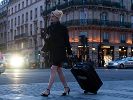Eye For Film >> Movies >> A Lady In Paris (2012) Film Review
A Lady In Paris
Reviewed by: Anne-Katrin Titze

The reason most people will go and see Estonian filmmaker Ilmar Raag's A Lady in Paris (Une Estonienne À Paris), is Jeanne Moreau. And boy, do they get her. "Am I a monster?" her Frida asks sweetly, "You act like one!" is the correct response.
A photograph in a richly furnished Paris apartment shows the young Moreau with a scrubbily scruffy cat. The very pale, blonde, ghost-like Anne (Laine Mägi), who just arrived from Estonia, hired to be caretaker for the elderly Frida, herself an emigre from Estonia to Paris in her youth, has not yet met the lady of the house. Stéphane (Patrick Pineau) is the go-between, the one who hired Anne, picked her up from the airport, and whose relationship to Frida, looks simpler than it turns out to be.

Jeanne Moreau's Frida is a pest - a rich, spoiled, elderly pest who acts like a child, wears cognac coloured silk pajamas and massive Chanel necklaces. She slurs her words, is grumpy and unbearable, and every so often, friendly, like a snake in the grass. She flirts, demands full attention and is a star. No one other than Jeanne Moreau could get away with this. When Anne, after a French inquisition, informs the poking Frida that there is no man in her life and that she has been divorced for 12 years, Moreau throws such a mad stare at the poor housekeeper, you are almost convinced that such personal negligence must indeed be a crime.
The film works with classic juxtapositions of the country mouse and the city mouse.
On nightly walks through the metropolis, Anne, the stranger in Paris, looks at her reflection in shop windows - a boutique, a couture studio, a display of lacy bras with birds. Her own clothes are ugly, worn out, ill fitting, they scream of poverty and the former Eastern Block. She sees herself reflected in the modish dresses, becomes self-conscious, until suddenly, she reaches the Arc de Triomphe. Paris is that way, a new promise might be right around the corner.
As the two women reluctantly get to know each other, Raag also unravels some culture-clashing customs.
The Estonian country mouse cooks leek and potato soup, prepares a pale plate of cheese and pink cold cuts, plus a yoghurt to serve her new boss - for breakfast. Jeanne Moreau's exhibition of outright horror is very funny. She takes tea and a croissant, thank you very much. On goes the food circus act, as we watch the purchase of a pre-packaged supermarket bag of spongy pastry horns. "You expect me to eat plastic?" Of course we don't. Croissants can only be bought in a bakery.
The lessons, most of them good ones, keep coming and coming: "Has nobody told you to not mix perfume and not to take your shoes off indoors?" Obviously not.
When Anne is out on the street, she is on her own. She misses her Métro stop, because she waits on the wrong side for the doors to open. It's a slender film. A bit pale, like the light at the Baltic Sea, or a piece of ham that's been left on the plate too long.
Why should this lady, who made her life in Paris, be especially drawn to a lady who comes from the lands she left long ago? No special Estonian spirit connects them. The compatriots who congregate at the Lutheran Evangelical Church in Paris and bond over their musical heritage aren't too thrilling, either. "I hope you understand why I hate them," says Frida.
The Louvre? You haven't been? "The real Parisians never go to the Louvre," says the lady of the house, who wants back the key to her medicine cabinet. How Moreau fiercely plays out desire for control, matches Charlotte Rampling's performance as the bed-ridden matriarch in Fred Schepisi's Eye Of The Storm (2012). "I can't be a threat any more, can I?" Moreau could ask the same. It is difficult to feel pity for either grande dame's loneliness.
Patient, aching, smart Anne transforms as her employer gifts her a Burberry trench coat. She looks better and better. A big reveal are Anne's legs, maybe not enough to carry half the weight of the movie. Sudden chemistry, and a Breakfast At Tiffany's moment at the Trocadero, looking towards the Eiffel Tower, featuring a bakery bought buttery croissant, light up a new passage.
Raag works with a thin plot. He skates around on the surface of themes such as home and immigration. A Lady In Paris could best be served as a short three-person play.
Reviewed on: 27 Feb 2013
















